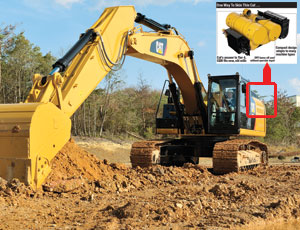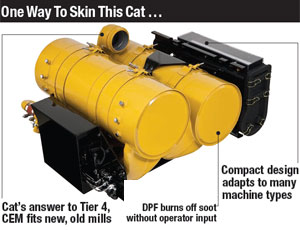The next phase of U.S. regulations aimed at cleaning up airborne emissions from off-road diesel engines will start taking effect in just nine months. The rule, called Tier 4, will all but eliminate the amount of diesel particulate matter (soot) and nitrogen oxides (NOx) that new construction equipment will put into the atmosphere.


Split into two subrules, the Tier 4 standard begins phasing in with an interim rule in January 2011 for engines from 175 horsepower to 750 hp and, in 2012, for engines from 75 hp to 175 hp. The Tier 4 rule cuts down the soot an engine may emit by 90% compared to the current Tier 3 standard, and it cuts the amount of NOx an engine is allowed to put out by 45%. What will follow in 2014 is an even tougher Tier 4 Final standard, which will cut NOx output by another 45%. Then, new construction equipment will emit virtually no NOx or soot.
Cleaning up the air will have a powerful effect on the health of millions of Americans. The EPA says diesel-powered off-road equipment now puts out 47% of the soot and 25% of the NOx spewed into the air by mobile sources nationwide. How much will the clean-air standards improve health? According to the U.S. Environmental Protection Agency, which drafted the rules, by 2030, when the country’s fleet of older, non-road diesel engines has turned over, the cleaner air will eliminate 12,000 premature deaths, 15,000 heart attacks, 200,000 cases of asthma symptoms in children and one million lost work days each year.
Two Strategies
EPA’s clean-diesel standards, including the upcoming Tier 4 regulations, apply only to new off-road equipment sold for use in the U.S. Manufacturers are responsible for making sure the equipment they sell meets current standards. In general, equipment manufacturers are choosing between two strategies for reducing NOx and soot to meet the Tier 4 Interim standards. Their choices are based on engine size, power loads and individual application demands.
The first technology is a combination of a cooled exhaust-gas recirculation system (EGR) and a diesel particulate filter (DPF). EGR is an in-cylinder technology that cools some exhaust gas leaving the engine and routes it back into the cylinder, which reduces the combustion temperature and, in turn, cuts NOx formed during combustion. It is commonplace on most on-road diesels today.
Although this approach reduces NOx, it tends to create more soot. (Lower combustion temperatures result in more soot and less NOx; higher combustion temperatures result in the opposite.) Manufacturers using EGR will add a DPF to the tailpipe to trap and periodically incinerate soot.
Nearly all the major equipment manufacturers—including Caterpillar, Case/New Holland/Kobelco, Komatsu, Deere, Volvo, Terex and engine specialist Cummins—plan to use this approach on some or all of their interim models.
The other major technology for reaching Tier 4 Interim levels is running the engine hot enough so that combustion produces very little soot in the cylinder. This approach tends to create higher levels of NOx, so manufacturers using this method will employ selective-catalytic reduction (SCR) for the Tier 4 Interim standard. SCR converts NOx fumes to harmless nitrogen and water by dosing them with small amounts of diesel exhaust fluid (DEF), an aqueous urea solution sprayed downstream of the engine.
Manufacturers that say they plan to use this approach for meeting Tier 4 Interim clean-air requirements on some equipment include Case/New Holland/Kobelco and Terex. Only JCB has said it will meet the Tier 4 Interim clean-air standards for products in the 75-hp to 175-hp range without a DPF or SCR. However, JCB says it may add SCR to meet the Tier 4 Final rule.
Although only a few equipment manufacturers say they are definitely planning to use urea to meet the further...


Post a comment to this article
Report Abusive Comment